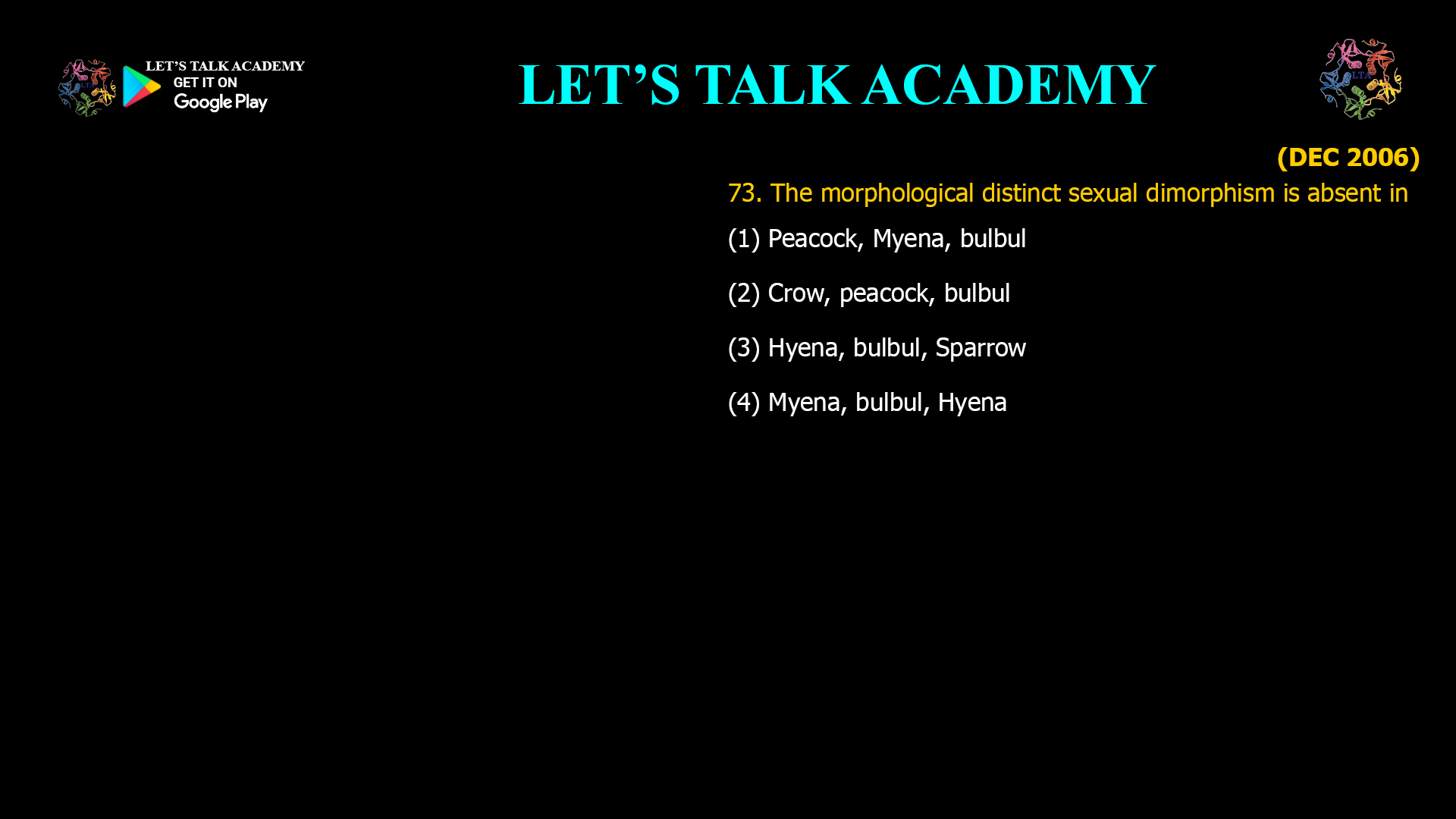- The morphological distinct sexual dimorphism is absent in
(1) Peacock, Myena, bulbul (2) Crow, peacock, bulbul
(3) Hyena, bulbul, Sparrow (4) Myena, bulbul, HyenaWhat is Sexual Dimorphism?
Sexual dimorphism refers to differences in appearance between males and females of the same species. These differences can manifest in various ways, such as:
-
Size: Males may be larger or smaller than females.
-
Coloration: Males often display brighter colors or elaborate patterns.
-
Morphological Features: Specialized structures like antlers, manes, or ornamental feathers.
These traits often arise due to sexual selection, where individuals with certain characteristics are more likely to attract mates and pass on their genes.
Species Without Morphological Sexual Dimorphism
While sexual dimorphism is common, some species show little to no visible difference between the sexes. In the context of the options provided, the correct answer is: Myena (myna), bulbul, and hyena. Let’s explore why these species lack obvious sexual dimorphism.
1. Myena (Myna)
The myna is a well-known songbird found across Asia. In most myna species, males and females look almost identical. Both sexes share similar plumage colors, patterns, and sizes. This lack of dimorphism is likely due to their social structure and mating systems, where both parents are involved in nest building, incubation, and feeding the young. Since both sexes share similar ecological roles, there is little evolutionary pressure for them to develop distinct appearances.
2. Bulbul
Bulbuls are another group of songbirds found throughout Africa and Asia. Like mynas, bulbuls exhibit minimal sexual dimorphism. Males and females have similar body sizes, feather coloration, and markings. In many bulbul species, both parents participate equally in raising offspring. The absence of sexual dimorphism may help reduce predation risk, as neither sex stands out more than the other, and both can blend into their environment while caring for their young.
3. Hyena
Hyenas, particularly the spotted hyena, present a fascinating case. Unlike many mammals, male and female spotted hyenas are very similar in size and appearance. In fact, females are often slightly larger and more dominant, but the differences are subtle and not easily distinguishable at a glance. Both sexes have similar coat patterns and body shapes. The social structure of hyena clans, dominated by females, means that overt sexual dimorphism is unnecessary. Instead, behavioral and social cues play a more significant role in distinguishing the sexes.
Why Is Sexual Dimorphism Absent in These Species?
The absence of morphological sexual dimorphism in myna, bulbul, and hyena can be attributed to several evolutionary and ecological factors:
1. Shared Parental Roles
In species where both males and females contribute equally to parental care, there is less need for one sex to develop specialized traits for attracting mates or defending territory. Similar appearances may also help both parents avoid predation while caring for their young.
2. Social Structure
In highly social species like hyenas, dominance and mating opportunities are determined more by behavior and social rank than by physical appearance. This reduces the evolutionary pressure for males and females to look different.
3. Environmental Pressures
Camouflage and predator avoidance can favor similar appearances in both sexes. Bright colors or exaggerated features may attract predators, so species that rely on stealth or blending in are less likely to evolve sexual dimorphism.
4. Mating Systems
Monogamous or cooperative breeding systems, where pair bonds are strong and both sexes invest heavily in offspring, often result in reduced sexual dimorphism. In contrast, polygynous species, where males compete intensely for mates, are more likely to develop pronounced differences.
How Does the Absence of Sexual Dimorphism Affect Behavior?
The lack of visible differences between males and females can influence social interactions, mating behavior, and parental care:
-
Mating Behavior: Mate selection may rely more on vocalizations, displays, or behavioral cues rather than physical traits.
-
Parental Care: Equal investment from both parents can lead to higher survival rates for offspring.
-
Social Dynamics: In species like hyenas, dominance hierarchies are established through behavior rather than size or ornamentation.
Examples of Sexual Dimorphism in Other Species
To better understand the significance of its absence, it’s helpful to compare with species where sexual dimorphism is pronounced:
-
Peacock: Males have extravagant tail feathers to attract females, while females are drab and camouflaged.
-
Lions: Males have manes, while females do not.
-
Mallard Ducks: Males display bright plumage, while females are brown and inconspicuous.
These differences often arise from intense sexual selection and differing ecological roles between the sexes.
The Evolutionary Trade-Off
While sexual dimorphism can provide advantages in mate attraction or competition, it also comes with risks, such as increased visibility to predators. Species like myna, bulbul, and hyena have evolved a different strategy, prioritizing survival, cooperation, and social cohesion over physical differences.
Conclusion
Morphological sexual dimorphism is a fascinating aspect of animal biology, but its absence in species like myna, bulbul, and hyena highlights the diversity of evolutionary strategies in nature. In these animals, similar appearances between males and females reflect their shared roles in parenting, social structure, and survival. Understanding why sexual dimorphism is absent in certain species not only deepens our appreciation for the natural world but also sheds light on the complex interplay between evolution, behavior, and ecology.
-




1 Comment
Kajal
October 15, 2025Myna,bulbil and hyna